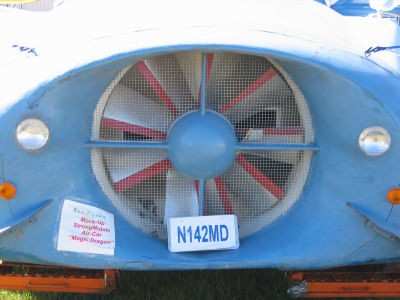Well, Maybe Not Quite Yet…
By Rob Finfrock
It's a dream that has been around ever since the postwar era, if
not before: combining the functionality of an automobile with the
"go anywhere, any time" convenience of an airplane.

There have been many attempts thus far, but all have proven to
be, ah, less than successful (anyone for a flying Pinto?)
Nevertheless, research programs and full development plans continue
towards achieving this goal, with the Moller M400 Skycar being
probably the most identifiable.
And then there is Richard Strong, a retired Air Force captain
who holds a patent on multi-mode vehicles, and who has been working
on the concept of a flying car since 1960. A full-size mockup of
his design was located north of the main entrance to AirVenture
2005 at Oshkosh. He also presented a forum titled "Magic Dragon
StrongMobile Roadable Aircar Project."
"This is the eighth model," says Strong. "We've been through a
tether model for flying and checking it, a wind tunnel model for
measuring, and several half-size models. This is a preview of the
future."
As visions of the future go, the current mockup looks something
like a leftover prop from an episode of the 1950s serial "Flash
Gordon." It looks somewhat futuristic, from a distance. Upon closer
inspection, however, you realize that it is actually quite
crude.
The main body panels are constructed from plywood, as are the
wings; the front nosecone appears to be formed with plaster over
chicken wire; and the instruments are printed on sheets of paper
taped to the dashboard. The steering wheel is from an early Geo
Metro, as are parts of the suspension. The mockup's blue paint
scheme covers everything, including the tires.

Passersby seem equally captivated and contemptuous at the
spectacle before them. For every person who stops to consider the
vehicle and pick up some literature, others laugh derisively at
it.
I must admit that the first time I saw the Magic Dragon, my
first reaction was to look at Strong and say, "I'm trying to
determine if you're serious or not."
He is. Moreover, Strong has apparently given a lot of thought to
his creation. Detailed schematic drawings are available for review
on his website. He has performed a test program, much as other
manufacturers do. And while Strong has yet to build a flying
prototype, he has done studies and determined what he believes to
be realistic performance capabilities.
"I would say [the service ceiling] would be like any other
airplane, like a Cherokee or a 172." Strong plans to use an engine
producing approximately 200 h.p. to accomplish this, most likely a
liquid-cooled automotive engine "for the low maintenance." Power
would be channeled through the wheels on the road, and a three-foot
ducted fan in flight. Wings would extend from the body
electronically when the owner decides to go into airplane mode.
What material should be used to build the vehicle is another
matter. The mockup is constructed of wood ("Wood's cheaper to
modify," says Strong with a laugh) but the ultimate body shell
would likely be metal.
"I get different opinions," says Strong. "Personally I'm sort of
old-fashioned, I'd go with aluminum. Of course, the front would
have to be some kind of composite... it's all about matching the
technology with the need."
Target weight for the prototype is 2700 lbs, including full
safety equipment such as passive restraints, with a "generous"
passenger and baggage allowance on top of that.

Who knows if Richard Strong's dream will ever fly or not. He has
displayed at Oshkosh for several years, and is a member of the EAA.
He is slowly building his prototype, and is always looking for an
investor to help with costs. When talking to him, it is very clear
that he firmly believes in his vision.
"It will be a nice, comfortable, easy to fly, vehicle."
 Aero-News: Quote of the Day (04.28.25)
Aero-News: Quote of the Day (04.28.25) ANN's Daily Aero-Term (04.28.25): Decision Altitude (DA)
ANN's Daily Aero-Term (04.28.25): Decision Altitude (DA) ANN's Daily Aero-Linx (04.28.25)
ANN's Daily Aero-Linx (04.28.25) Airborne-Flight Training 04.24.25: GA Refocused, Seminole/Epic, WestJet v TFWP
Airborne-Flight Training 04.24.25: GA Refocused, Seminole/Epic, WestJet v TFWP Aero-News: Quote of the Day (04.29.25)
Aero-News: Quote of the Day (04.29.25)





